OVERVIEW
2020 has been quite a year. For some of us, it may seem like the longest year on record, while some are left wondering where the past nine months have gone; however, for a select few, Time was more than just a way of keeping track of this dumpster fire of a year—it was also a class aimed at reflecting “on the deep mysteries of time, while also building hands-on skills that will improve our command of temporal media and technologies.”
My original goal for the final project was to really dig into the hands-on aspect of commanding the temporal device known as the escapement by building on my midterm project. Having played with escapements, and even created a working franken-escapement (see the end of my aforementioned post), I hoped to elaborate a clock by adding pieces designed with social aspects in mind. Unfortunately, it’s 2020.

With easy access to the proper equipment not really being an option,*** I decided to refocus on what was available to me that would also allow me to produce something physical with my hands. I thought about my shift in direction for a few days, making a list of related ideas that fit (as many of) the categories of “inspirational”, “available”, “applicable”, and “fun/interesting” as possible.
Of course, it was hard to escape the most obvious things; for one, regardless of whether I was counting it or not, time was always going and, two, being immunocompromised, I currently spend just over 99% of my time at home. “How could I make the most of this situation?” I thought back to the summers when I was a kid. At home all day with my sister while my parents were away at work, many a summer, I spent my days looking forward to my favorite program on Nickelodeon, Mr. Wizard and trying not to let him get me into trouble.
Fortunately for my parents, he only came on three times a week; fortunately for me, I had a very understanding father who confessed to me after I almost flooded the kitchen (or was it almost stain the bathroom countertops?) that he, too, had fallen victim to Mr. Wizard as a kid in the 1950s, so I was often forgiven quickly in these matters. (Worth noting, Wikipedia describes Mr. Wizard as being ‘credited with turning “a generation of youth” in the 1950s and early 1960s onto “the promise and perils of science”.’ Thanks, Mr. Wizard.)
All of this brought me here—not just to being nerdy enough to enroll in a class called “Time”, but to my theme for this final project—“Time at Home.”
What follows is the result of several weeks of researching and adapting time-related projects (in the vein of Mr. Wizard) along with commentary, suggestions, a few things to think about, and other observations from my “Time at Home.” I wanted to display this in a format that would allow other families/tinkerers to enjoy together, when possible, and alone, when not. Time can be a very complex idea to wrap your mind around, but doesn’t have to be. This project formed aimed at speaking to everyone who can read and wants to learn more about time.
I hope you enjoy. Should you do any of these projects with YOUR Time at Home, please, let me know in the comments below! I’d love to hear how they went for you and if you have any suggestions. I particularly love to hear about things people find surprising in what, at face value, my seem like fairly straightforward experiments.
The last section of this post is called “PROJECTS” and it contains three for you to follow along with and to think critically about. The time-related projects are: a potato/lemon clock, a customized paper sundial, and a water time with a bell alarm. I hope you enjoy.
OBSERVATIONS
First of all, I want to comment on time as something that exists—both as something that just happens and as something that we as humans talk about. If you’re not sure what I mean, I want you to close your eyes and think of a chair. What is the likelihood that you thought about the exact same chair as I did when I wrote this? (If it’s not pink with animal print accents, then it DEFINITELY wasn’t the same chair.)
I mention this because the word ‘chair’ is something we use to describe a specific thing. If I tell you a story about someone sitting in a chair to get a haircut, then a story about someone pulling out a chair at a fancy restaurant… would you imagine the same chair? Probably not. The same is likely true about cars, jackets, and eating utensils (like forks and chopsticks.) So, why is it that when talk about time, we can be so specific?
Well, the answer’s not so simple, but it’s good to keep in mind that not everyone measures time the same way. When I was a kid, there was a neighbor younger than me who couldn’t tell time, yet. Whenever he wanted to know when something was, he’d ask “How many (episodes of) Teenage Mutant Ninja Turtles is that?” (For the record, episodes were 30 minutes… and, for someone who couldn’t figure out how to tell time, he was really good with fractions—at least when it came time to Ninja Turtles.)

It’s not just because people can’t read a watch that they tell time differently. I recently read about different types of time in a book called “A Sideways Look at Time” by Jay Griffiths which is on the subject of time, framing it in non-traditional (at least to Westerners) terms. Combined with my general curiosity and tendency to (mentally) chew on things, I’ve thought a lot about many of these concepts and elaborated on them a bit to share with you.
Here are a few of my favorite examples of these perspectives on—or you could call them different types of—time:
KID TIME VS GROWN-UP TIME
Grown-ups have the advantage here, since they’ve experienced both kinds. I probably don’t have to explain too much about this, but will so that we’re on the same page. I’m sure the kids hearing this have felt like time pass soooo slowly. If anyone is having trouble remembering, try thinking about sitting through things like extra-long Sunday services, enduring your least favorite class, or waiting for summer break to start. Similarly, think about how many grown-ups say things like, “Wow. Has it already been a month?” or “Time flies as we get older”?
Something to think about. When are grown-up time and kid time most opposite? When are they most the same? Try talking about it with someone older or younger than you who can (still) talk.
Another interesting difference between kid time and grown-up time is how we think of animals, for example, in children’s time, animals may “live” – – often only as pets or Tom and Jerry cartoons, but there is extreme care and attention paid to the well-being of these figures. Meanwhile, “adult” time, where grown-ups—who are the most empowered people on the planet—live, is seeing careless ways of treating nature and the environment result in a very real history of the extinction of animals, both land and sea. See? Maybe there are some advantages to living in kid time!
Something else to think about. What might be some other advantages to living in kid time? What are some things people living in adult time could do to help keep these disappearing, endangered creatures alive better?
MYTHIC TIME VS HISTORIC TIME
Myths, legends, and other fantastic stories have a time system of their own, tending to be cyclical/circular when compared to historic time, which tends to forward, from past to present (where we are now) to future. Interestingly, there is great symbolism to be found here. Many, if not most, of us think of Greek and Roman mythology when it comes to myths and mythic time. Common in symbolism in mythic time are snakes. For this, think of a snake coiled, like a circle; circles commonly represent cycles of regeneration and renewal. If you want to see a very interesting depictions of this circular snake idea, do a Google Image search for ‘ouroboros’ which entered western tradition most notably in alchemy and, now that you’ve seen it, will start appearing everywhere you look.

Scratching your Head? Did you just say snakes mean Renewal? If this doesn’t make sense why, try looking at a clock (the kind with hands) and follow with your imagination the long hand as it goes in a circle. When does something stop it? Never… and that’s the idea. Think about it, what happens when the hand reaches the top? A new hour starts—that’s where ‘re-new-al’ comes in.
As many of us know, Christianity is based in a story that begins with a snake betraying fig-leafed humanity in a garden, so it shouldn’t surprise you that (Judeo-)Christian traditions are great snake haters. Interestingly, Christianity not only differs from previous mythical stories by being anti-snake, it also falls much more into the category of historic time—a linear view of history believing that time is irreversible, inevitably leading us to a non-renewing death on earth (before moving on to the afterlife.)
Here are a couple more comparisons that make help you better understand the difference:
- Mythic time is slippery of meaning. (Think: “Once upon a time there was a magical princess with skin as white as snow and hair long enough to be a ladder, who lost her shoe at a ball…”)
vs
- Historic time is cut and dry. (Think: “July 4th, 1776, the Second Continental Congress unanimously adopted the Declaration of Independence…”)
- History depends on the explicit and visible nature of written language. (Think: Printed books.)
vs
- Myth allies itself with the implicit and invisible. (Think: Spoken storytelling.)
Interestingly, for most of human’s storytelling history, the moon was a mythic being, often talked about in folklore; it was a figure in the sky in a place we’d never been to. That changed on July 20th, 1969 at 10:56PM (New York City time), when Neil Armstrong landed on the moon. When he touched it, the moon ceased to be mythic—for myth is the opposite of history.
Mythic vs Historic? Is One Better Than The Other? The answer is that you could argue for both sides for different reasons. There are clear advantages to historic time, like having precise dates/times logged in a way that people can look back and read what was written. Folklores, for example, because they are part of mythic time and, therefore, the past in folklores is ambiguous and open to meeting. At first glance that may sound confusing; for those familiar with folklore, it’s not. And, because these stories when told are left to be interpreted by the listener, it is inherently democratic—meaning it gives the power to the individual listening to decide many details of the story in his/her imagination. Additionally, these stories can be told by anyone who knows them.
History, by contrast is undemocratic. Think about who writes our history books (hint: it’s the people who won) and how do we learn about these stories (hint: usually by experts who have learned from those books and people who’ve read those books.) When’s the last time a history teacher suggested you invent details for a test? Not usually; historical time’s details are non-negotiable. One thing I really like about mythical time is that, when it comes to folklores, every child is the potential expert—often correcting adults for mis-telling a story!

UNDERSTANDINGS OF TIME RELATED TO PRESENT
Here are a few perspectives on time I was unfamiliar with until I read about them this semester:
- Aboriginal Australian Dreamtime is an extraordinary model of time, considered to be “extraordinary” as it is outside (extra) the ordinary order of time, which is concrete and actual. With this type of time, storytellers singing these stories is not memory of time in the past, but participation in a vast, symbolic, depth of present time. This is because the Dreamtime merges past, present, and future and—just like dreams—can make past, present, and future lap at each other. Singing those stories is not memory of time-past, but participation in a diffuse, metaphoric, depth of time-present, for the Dreamtime merges past, present and future, as dreams can make past, present and future lap at each other.
- The Arakmbut people in the Amazon in Peru say, “Without the knowledge of history, the land has no meaning; without the land, neither the Arakmbut history nor culture has any meaning.” “Land and history” being inseparably linked, it doesn’t sound too far-fetched; however, if putting it as “land and time” is hard to completely grasp as an idea—even though time is SO linked with history, you’re not alone.
- In Navajo myths and ritual, past, present and future are interchangeable.
- For the Jivaro peoples in Ecuador, they start their myths with “a long time ago, a long, long time ago…” and tell their stories in the imperfect tense (have eaten, have played)—which is a verb tense that talks about the past but is tied to the present… you can usually use words with these kind of verbs like “today” or “(all the way up to—and including—this point) in my life”—rather than in the past tense—which happened before this moment…you can usually use words with these kind of verbs like “yesterday” or “when I was a kid”. What’s very interesting is that the Jivaro usually end these stories in “now”; in these tales, there is no absolute and simple break between now and then/the past.
You Made My Brain Hurt. Don’t worry if you don’t totally understand all this. The important thing to remember here is that the Aboriginal Australians use the Dreamtime form of storytelling in a way that is as common and understandable to them as our stories are to us. Both are valid ways of talking about time. The point is that time is more than just the seconds, minutes, and hours on a clock. Don’t forget, this type of storytelling and understanding of time comes from a period before modern clocks! How might have people lived before the modern clock? What are some ways people could tell the passage of time without a clock? Before you open up another browser tab and Google it, take some wild guesses. Fortunately, for you—person in the 21st century, if you come up with nothing, at least you have a clock in front of you. (Tip: Just ask more programmers and they’ll tell you, a computer is just a clock with benefits.)
Time Without A Clock

In the section above I asked, “What are some ways people could tell the passage of time without a clock?” This is something that I’ve thought a lot about… more specifically, “What are some ways of thinking about time that don’t involve a clock?” I’ve been trying to put together a list of things that I’ve noticed give me clues to the passage of time. Of course, there more things than just these, but I wanted to give a few different kinds of examples:
- 10 – 15 seconds — from the time the gate opens to the time the delivery person rings my buzzer;
- 20 seconds — singing happy birthday to myself twice while standing at the sink.
- 4 min — recommended time for taking a shower while conserving water; also the time it take to sing any of these songs to yourself in the shower:
- 4-½ to 6 min — time for my moka pot to brew coffee; (warm summer day vs cold winter day)
- 30 min — a broadcast sitcom
- 42 min — baking time for perfect brownies (or a broadcast drama)
- 1 hour 4 min — quick wash cycle on my dishwasher
- 1 day — sunrise (from the day before)
- 1 week — the start of any of my classes
- 2-3 weeks — change toilet paper roll; for a lavender flower from bloom to fade
- 28 days — full-moon out the window
- 1 month — direct deposit notifications
- A year — Christmas Day, your Birthday
- A year-ish — Christmas time, celebrating your birthday, holiday lights going up across the street
- Kind of a year — Thanksgiving/Black Friday, Easter
Time at Home… Away-from-Home Time — Something to think about, Game of Thrones follows the stories of its characters over a period of about 5 years. To watch every episode of this tale back-to-back, it would take 2 days, 22 hours, and 14 minutes. If you convert how long it takes you to watch one YEAR of characters’ lives in GOT to time in front of the screen, it would take over 14 hours.
Similarly, if you were to watch all nine episodes of Star Wars back-to-back—which follows its characters over a period of about 76 years—it would take you 20 hours and 39 minutes. If you convert how long it takes you to watch on average one YEAR of characters’ lives in the Star Wars series to time in front of the screen, it would take over about 16 minutes.
SUPER-DUPER EXTRA-CREDIT. So, keeping track of all of these things over the past few weeks, I’ve been looking over the list trying to see if anything stood out as interesting. For me, where I ended up was looking at my list and feeling like the examples fall into one of two categories: Clocks & Timers. The next part of this project will contain a few projects which will fall into each of these categories. Before moving on, what do YOU think is the difference between clocks and timers? If you made a list of each’s qualities, what would you list under ‘clocks’ and what would you list under ‘timers’? What things are the same in both lists? What things are unique in each list?
PROJECTS
In the previous section, you were given SUPER-DUPER EXTRA-CREDIT where you were asked to list the similarities and differences between a clock and a timer. If you haven’t thought that, yet, I encourage you to do so. As you go through these projects, I also encourage you to think about how it has changed your concept of what a clock and what a timer is.
PAPER SUNDIAL
Creating a simple sundial isn’t that tricky… especially if you’ve got a watch to help calibrate it; however, more accurate ones tailored to your location can be created using different measurements and formulas. I’m pretty sure back in the day people used to do those calculations with a set of reference books and a slide rule (if you don’t know what a slide rule is, you should check it out), but, nowadays, fortunately, you can enter a your latitude and print one out based on your location! Technology is awesome!
I tried a few of these out including:
Printable Popup Sundials Print, cut and fold.
This one has not only the option of printing out your sundial, but you can share your location with the page and the site will determine your latitude for creating the sundial. THIS WAS THE ONE I USED FOR CREATING & PRINTING OUT MY PAPER SUNDIAL.
Paper sundial – How to make a sundial
This site has a lot of information, but it’s spread out on different pages using links, so it’s not very clear if what you’re looking for is there. That said, if you’d like to see images of different types of sundials and are interested in checking out some the tools available by this site (which doesn’t appear to have sundial generator), I’d say it’s worth popping in and looking around.
STARGAZING BASICS HOW TO MAKE A SUNDIAL THE SIMPLE WAY
This one doesn’t have a calculator on it, but it has links to print out a sundial and it has quite a few helpful pictures if you’re a visual learner.
NASS – Analemmatic Sundial – How it Works
This site is more informational; if you’re interested in learning more about our position and the angles for creating a more elaborate sundial, this site may be for you.
Here’s how mine looked when I tried it out:
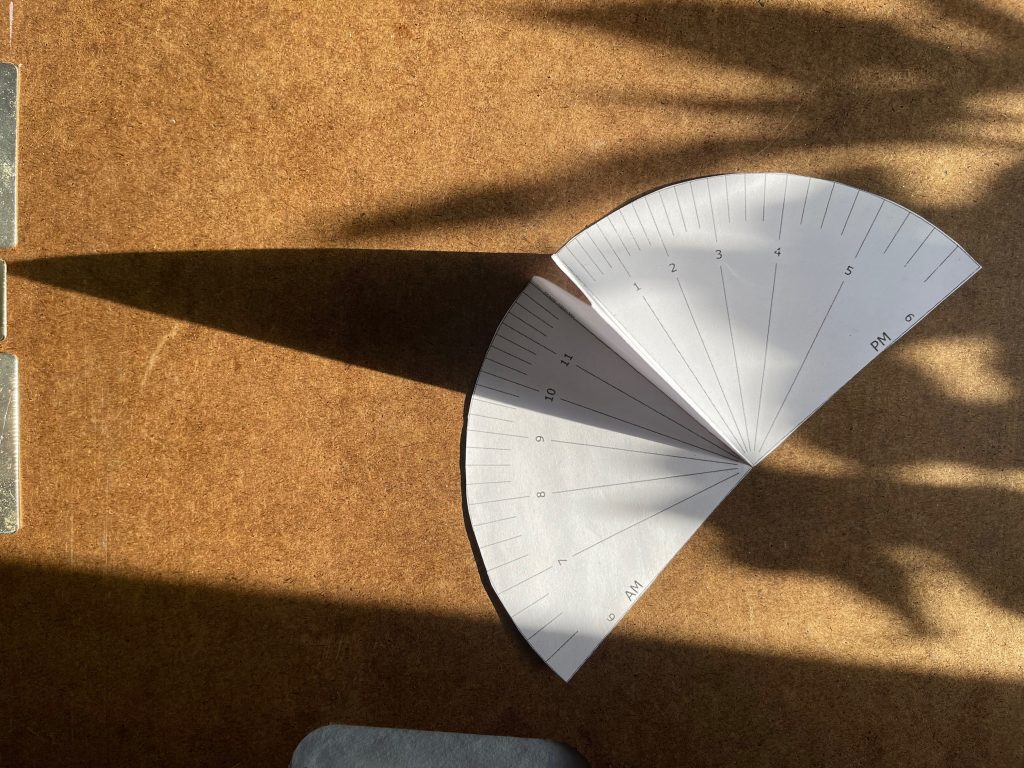
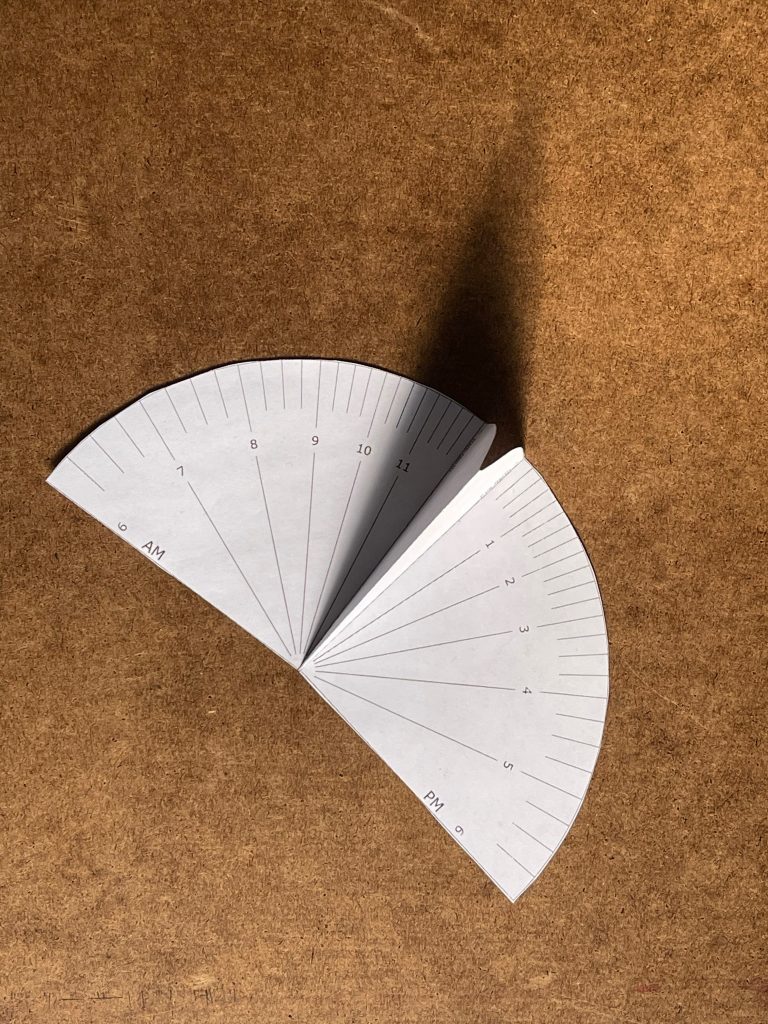
First, let’s talk about the parts of a sundial, you’ve got the dial (which is like the clock face) and the ‘gnomon’, which some people call the ‘pointer’ (which casts the shadow on the dial to indicate the time.) As you probably guessed, well before watches and modern clocks, people used sundials to help note the passage of time. Here’s how/why a sundial works (this is from Wikipedia, but re-typed to make it more understandable):
A sundial is a device that tells the time of day using sunlight directly from the Sun. The simplest sundials consist of a flat plate (the dial) and a gnomon (a perpendicular rod), which casts a shadow onto the dial. As the Sun appears to move across the sky, the shadow aligns with different hour-lines marked on the dial to indicate the time of day. The gnomon may be a rod, wire, stick, or elaborately decorated metal casting.
While clocks and watches FAR outsell sundials (I made that up; if I’m wrong, please, send the link—when I Googled it, I couldn’t find world sales figures. sorry.), there are so many styles of sundials out there. In fact, if you search for ‘sundial’ on Etsy, you’ll people still making and selling all types of them.

Check out a few links I found with really great information and images on different sundials:
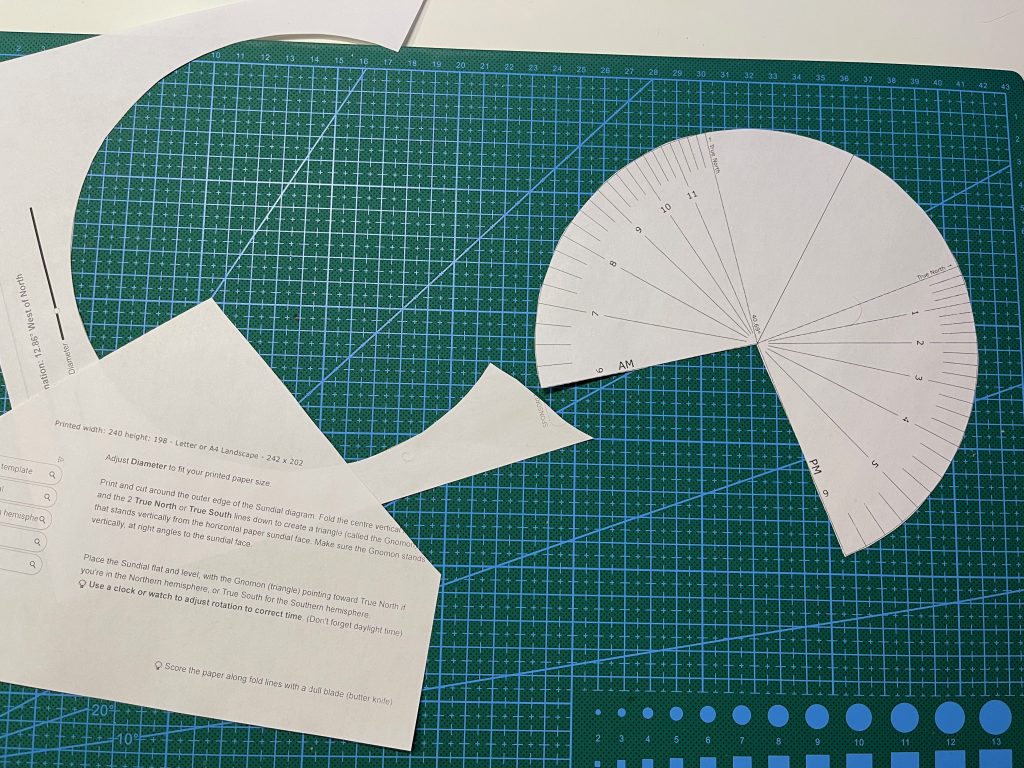
MAKE YOUR OWN. Using the first sundial link above (or just click here), enter your information and print out a customized sundial. (Quick Tip: On the sundial site, just above the diagram of the sundial, there’s a silver button labeled “What’s my Latitude?” Click on that, it will ask you for your current location and then create your custom sundial for you!)

NOW MAKE IT YOUR OWN. For thousands of years, people have been using trees (as the gnomon) and the ground (as the dial) for telling time (think “it’s about midday” rather than “it’s 11:59 and 58 seconds”). What other things—like the trees—can you think of that might produce a similar effect with the ground and the Sun’s shadow? Now, take your print out and decorate it to look like that!
POTATO CLOCK
If TV and movies are to be believed, in order to be a middle school student in the United States, you’ll have to make for school a project either: a baking soda volcano, some sort of diorama, or clock powered by a potato. I’d actually never done any of these popular school/science fair projects before I got to ITP (check out my Martin on the Dancefloor diorama I made for Cabinets of Wonder), so I was curious to see how different it would be from what I’d imagined. Before doing this project, I believed it worked… but… “could there be more…?” (No. Not really. It’s pretty straight forward.)
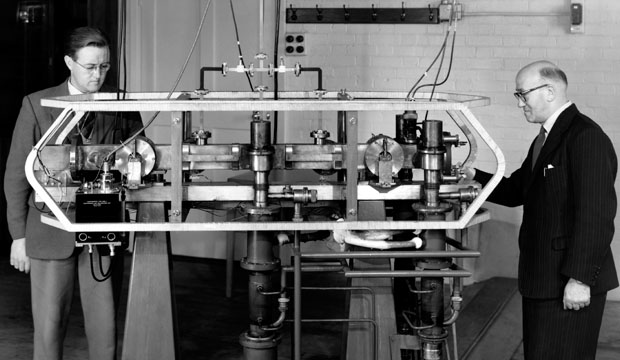
So, how does this relate to time? I mean, I could have done the same with an LED, but, to me, this is cool because it’s a reminder that, while we tend to think of ‘man’ and ‘nature’ as being two separate categories, underlying both of them is this common thread that exists at the core of what everything is made of, atoms. Essentially, time here is powered—through different processes—by the same thing that powers us. In the case of time and what makes a clock special (vs a light) in this experiment is that international time standards are also based on the atom’s pulse (specifically, the pulse of a caesium-133.) The International System of Units (SI) defines the second as the time it takes a caesium-133 atom in a precisely defined state to oscillate exactly: 9 billion, 192 million, 631 thousand, 770 times.
Atomic clocks are amazing! As weird as the definition of a second may seem, it’s estimated to only lose about a 1 second in up to 100 MILLION years (for the record, ONE year is 31,556,952 seconds long) making atomic clocks among the most accurate timekeeping devices in history. Compare this to a common quartz watch which can lose a few seconds a months or a fancy Rolex that can lose a few minutes a month, if you’re not that active.

So, What’s Going On Here? First of all, if you’re doing this with little kids who’ve never seen such a thing, I’d be curious to hear what they think is going on. As a curious kid in the 80s, I remember thinking how strange it was; I feel like, had we had more small electronics back then, I probably would have tried powering more things.
While a less conventional source of power, this experiment converts chemical energy into electrical energy via a potato/lemon… because of this, I thought it’d be interesting to connect the metal parts of the clock to my multimeter to see how they’re different. Over time, the voltage goes down at the chemical reactions take place, eventually not being strong enough to power the attached clock.
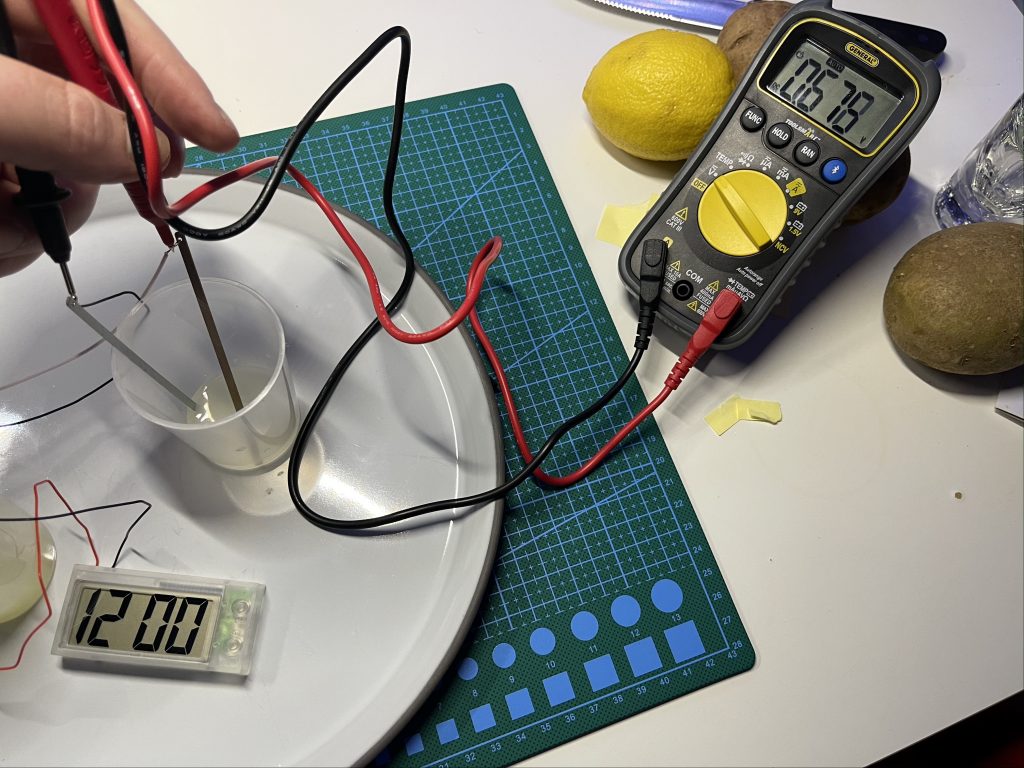

Wait. Did You Said Earlier A Rolex is Worse at Keeping Time Than a Timex?? Well, first of all, let’s talk about the difference, which is VERY MUCH on topic for this project. See, Rolexes (with a few exceptions) are powered using a different system than most Timex/inexpensive watches… and neither of them use potatoes. (Though, either directly or indirectly, they are powered by the same source as the potato/lemon clocks—energy!)
Rolexes, and many high-end watches, use mechanisms that are powered by movement. You see, when the watch is moved—like on your wrist while you’re walking, a disk inside turns around and helps wind up a part that stores energy that is slowly released. Cool, huh? Unfortunately, that means if you don’t wear your watch often enough or you have been especially lazy, the part that gets wound up doesn’t get wound enough… so, much like having a low battery, the clock slows down.
With a quartz watch, it’s not the quartz that’s powering the watch, but a battery that slowly releases energy that kinda ‘tickles’ the quartz crystal causing it to vibrate (at a very regular, predictable rate that can be counted) and every 32768 times that happens, the clock moves forward a second—I know it’s crazy! These vibrations cause by the electricity released from the battery are what helps regulate the accuracy of the time. Because of this, as long as your battery is good, you should expect the quartz watch to stay pretty accurate. Wanna learn more? Check out these links on automatic and quartz clocks.

Here are a few sites I found with info on these potato-style clocks:
https://www.real-world-physics-problems.com/potato-clock.html
https://www.instructables.com/Potato-Battery-Understanding-Chemical-and-Electric/?amp_page=true
https://sci-toys.com/scitoys/scitoys/echem/batteries/batteries.html ***super-informative with lots of pictures and even all the element/electron information at the bottom
WATER TIMER (WITH ALARM)
The key to making a timer like these is to know how much time it takes for the water to move from one part of the time to the other. Even though you hope to make a ‘minute’ hourglass timer, the likelihood that you make your timer and fill it with EXACTLY one minute’s worth of water is unlikely. So, how will you know how much water to use? It takes two things: Trial & Error and an accurate clock. (Or is that three things?)
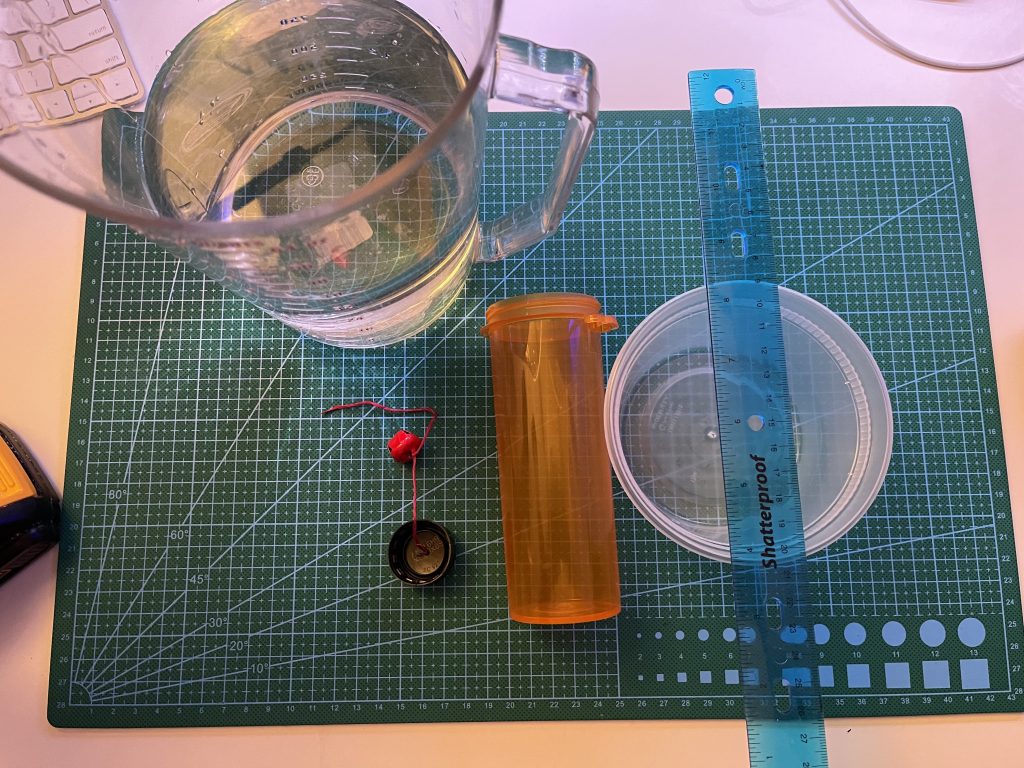
In terms of steps for creating a timer, the basics, no matter what style of timer you choose, are as follows:
- Create a hole in the bottom of a (disposable) container (like a cup/bottle)
- Without letting water (or sand) escape from the container (by covering the hole with your finger):
- fill the bottle with water; AND
- IMPORTANT: on the side of the container, mark a line where you fill the water level to
- Note the time on the clock in minutes and seconds (or use the stopwatch on your mobile phone) and time how long it takes for the water to completely empty the container. THIS IS HOW LONG YOUR TIMER IS.
- If you want the timer to last for a specific amount of time, repeat steps 2 & 3… either using more or less water/sand until you’re happy. That said, you’re free to repeat step 1 if you need to increase the flow.
YOUR OWN TIME ZONE How many things do you do in a day that take EXACTLY one minute? No more. No less. Probably not that many, so why make a timer that only measures a minute? Think of some things that you do often. If you made a timer that was made just for you and your schedule, what would it measure? How might having such a timer running while you do that activity affect how you do that activity? Now, think of what kinds of activities you might be able to measure using those tiny paper cups they give you at the dentist’s office? How about a plastic water bottle? a gallon milk jug? a pickle barrel?? an above ground swimming pool???
Here’s my timer. It doesn’t look like a lot of the closed water timers you see online that utilize water bottles, but I picked it because this one because of the alarm feature.


Here’s an overview of the setup for my timer from top to bottom: a jingle bell (attached to a string), resting on top of a stick (I used a ruler) that is resting on top of a cup that has a hole in the bottom of it. Tied to the other end of the string, hanging JUST ABOVE the bottom of the inside of the cup, is a plastic bottle cap (with a hole in the middle for the string.)
To use it, I place this ENTIRE setup on top of a jar/receptacle large enough for all the water to drain into. The idea is that the cap will float on the water when you fill the cup and, when the water drains, the cap will pull the bell off the ruler—sounding the ‘alarm’.
To make it, I created a tiny hole in the bottom of the plastic cup to act as the container for my water to go into. I then created the alarm by cutting a piece of string just a liiiiittle longer than the height of the cup—and, to one end, tying the jingle bell and, to the other end, attaching the plastic water bottle cap (by poking a hole in the middle and tying a large knot.) Repeating steps 2 and 3 until I got my timer to where I wanted it—measuring 1 minute exactly. What does *my* personal timer measure? My patience… I actually wanted to see how many times it would take me to get to exactly ONE minute. (14 times.)
I was torn between doing this project or a more traditional ‘hour glass’-type timer; however, I found those types of timers to be way more common when searching around, so I ended up using this alarm-style timer. The hour glass type timer (using two water bottles connected at the mouth) has two main benefits: 1) once you’ve got it set up properly, it’s a closed system so you don’t have to worry about water evaporation and 2) since it is a closed system, it’s potentially a much less messy (or at least less wet) project.
Since I came across a number of cool tutorials in making this, I wanted to give a list of cool timer sites I came across while researching these ideas. Here are some of my timer tutorial honorable mentions:
If you’re interested in trying it out with SAND:
- Instructables – Soda Bottle Sand Timer (TEXT, with pictures)
- Bottle Crafts : How to Make a Sand Hourglass With Plastic Drink Bottles (VIDEO; no words, but it shows how to make an hour glass with sand)
FOOTNOTE
***I was offered to test out a system where I could remotely send materials and plans to The Shop at school and have the pieces made for me; however, I’ve never had to laser cut anything that was intended to work with another thing—essential in clocks—and felt my time and, more importantly, skill level was too limited to attempt. That said, I’d like to give a special thanks to Jeff Feddersen and Ben Light for discussing and offering to arrange this for me. Your thoughtfulness means a lot!





